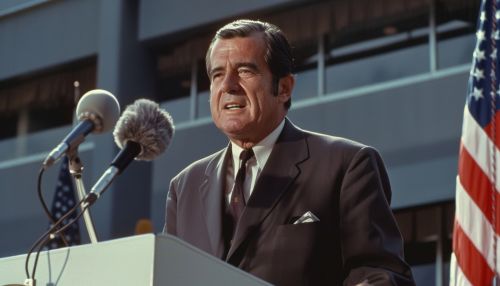Nixon Shock
Background
In the late 1960s, the United States faced a series of economic challenges, including rising inflation and a growing trade deficit. The Bretton Woods system, established in 1944, had fixed the value of the U.S. dollar to gold, and other currencies to the dollar. However, by 1971, the U.S. was unable to maintain this gold standard, leading to the event known as the Nixon Shock.
The Bretton Woods System
The Bretton Woods system was a monetary management system that established rules for commercial and financial relations among the world's major industrial states. The system was the first example of a fully negotiated monetary order intended to govern monetary relations among independent states. The chief features of the Bretton Woods system were an obligation for each country to adopt a monetary policy that maintained its external exchange rates within 1 percent by tying its currency to gold and the ability of the International Monetary Fund (IMF) to bridge temporary imbalances of payments.
Economic Challenges
By the late 1960s, the U.S. was facing a series of economic challenges. The country was running a balance of payments deficit and a trade deficit, the first in the 20th century. The year 1970 was the crucial turning point, which ended the post-war economic boom. The Vietnam War had accelerated inflation and the government was running massive budget deficits.
The Nixon Shock
On August 15, 1971, President Richard Nixon announced a series of economic measures in a televised address, which came to be known as the Nixon Shock. These measures included a 90-day freeze on wages and prices to counter inflation, a 10 percent import surcharge to safeguard American products, and most significantly, the unilateral cancellation of the direct international convertibility of the U.S. dollar to gold.
Impact on the Global Economy
The Nixon Shock had a profound impact on the global economy. It effectively ended the Bretton Woods system and led to a period of high inflation and economic uncertainty. The decision to abandon the gold standard led to a significant depreciation of the U.S. dollar against other major currencies. The end of the Bretton Woods system also led to the creation of the current system of floating exchange rates.
Long-term Effects
In the long term, the Nixon Shock led to a series of changes in the global financial system. It marked the beginning of the era of financial globalization and led to the dominance of the U.S. dollar as the world's reserve currency. The decision to abandon the gold standard also had significant implications for monetary policy, leading to the adoption of inflation targeting by many central banks.
Criticisms
The Nixon Shock has been criticized for its impact on global economic stability. Some argue that it led to the financial crises of the 1970s and 1980s, and contributed to the 2008 financial crisis. Critics also argue that the decision to abandon the gold standard has led to a long-term decline in the value of the U.S. dollar.
Legacy
Despite the criticisms, the Nixon Shock is seen as a pivotal moment in economic history. It marked the end of the Bretton Woods system and the beginning of a new era of global financial markets. The decision to abandon the gold standard has had a lasting impact on monetary policy and the global financial system.
See Also


